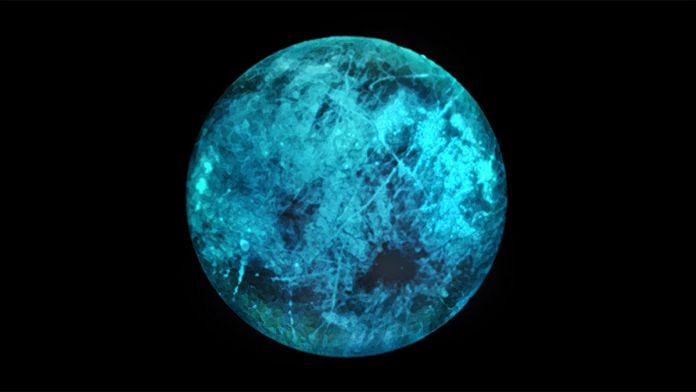Bengaluru: Jupiter’s icy moon Europa, which is set to be the next favourite exploration destination due to the presence of an under-ice ocean, may actually glow in the dark, NASA scientists have discovered.
The findings are predictions made from Earth-bound experiments at NASA’s Jet Propulsion Laboratory (JPL) in California, which recreated Europa and Jupiter’s interactions.
The team found that the moon possibly glows blue-white and blue-green through its ice and water interior, even at night, because of the radiation from its host planet Jupiter.
Although the glow has not been directly observed by telescopes yet, using a spectrometer to observe and identify different signatures in the composition of ice during Europa’s night can give insights into the evolution of Jupiter and its moons.
The findings were published Monday in the journal Nature Astronomy.
Also read: Jupiter-sized planet found orbiting a dead star — a first in space discoveries
The study
Murthy Gudipati, JPL astrophysicist and lead author of the study, and his team were working on experiments to understand how Jupiter’s incessant radiation affects Europa.
Jupiter emits the strongest radiation after the sun and is surrounded by the biggest planetary magnetic field in the solar system, which accelerates charged particles to high energies. This enormous magnetosphere spans over 1 million km in radius, engulfing Europa and many other moons.
Europa is one of the more promising candidates when it comes to potential habitability. The moon is covered with a solid crust made of water ice and is thought to hold a sloshing ocean of liquid water underneath. Water is one of the strongest biomarkers or indicators of potential habitability.
To understand the effect of Jupiter’s charged high-energy activity on its icy moon’s contents, Gudipati’s team built an ice chamber in JPL’s facilities, called the Ice Chamber for Europa’s High-Energy Electron and Radiation Environment Testing (ICE-HEART). The objective of the experiment was to understand how organic matter would react to radiation in Europa’s waters.
To simulate the moon, scientists had to add minerals present on the moon’s surface to the ice-water mix. These included a variety of salts including common salt. It is commonly known that high energy particles energise molecules, which then release energy in the form of light by producing a glow.
This chamber was exposed to a beam of high energy electrons, to simulate Jupiter’s effect on Europa.
The team discovered that whenever they beamed through the water, it glowed and the glow stopped when the beam was stopped. But what was unanticipated was the extent to which the glow changed as the contents of the water changed.
Also read: Saturn overtakes Jupiter with 82 moons — now has more than any other planet
An unexpected find
The unexpected finding instantly changed the focus of their research from organic matter to the glow-in-the-dark phenomenon.
Moons are normally visible at night because of sunlight that reflects off their surfaces or atmospheres. Europa, however, seems to be illuminated through the night, even with no sun, because of charged particles from Jupiter and its interior.
“Seeing the sodium chloride brine with a significantly lower level of glow was the ‘aha’ moment that changed the course of the research,” said Fred Bateman, co-author of the paper.
“If Europa weren’t under this radiation, it would look the way our moon looks to us — dark on the shadowed side,” Gudipati said. “But because it’s bombarded by the radiation from Jupiter, it glows in the dark.”
Europa is fast becoming the next big destination in planetary research thanks to findings from the ongoing Juno mission around Jupiter. Multiple missions to the icy moon are currently under consideration.
The JUpiter ICy moons Explorer (JUICE) is an interplanetary spacecraft in development by the European Space Agency (ESA). It will orbit the largest Jovian moon Ganymede and will also study Callisto and Europa in detail. It is scheduled to launch in 2022.
NASA’s Europa Clipper is the next and first mission dedicated to Europa. It comprises an orbiter that will fly around Jupiter but will make a series of close flybys to study the moon. The mission is set to launch in 2024.
Other missions including landers have been proposed, but none are approved yet.
Also read: An asteroid orbiting between Mars and Jupiter could be a new dwarf planet






